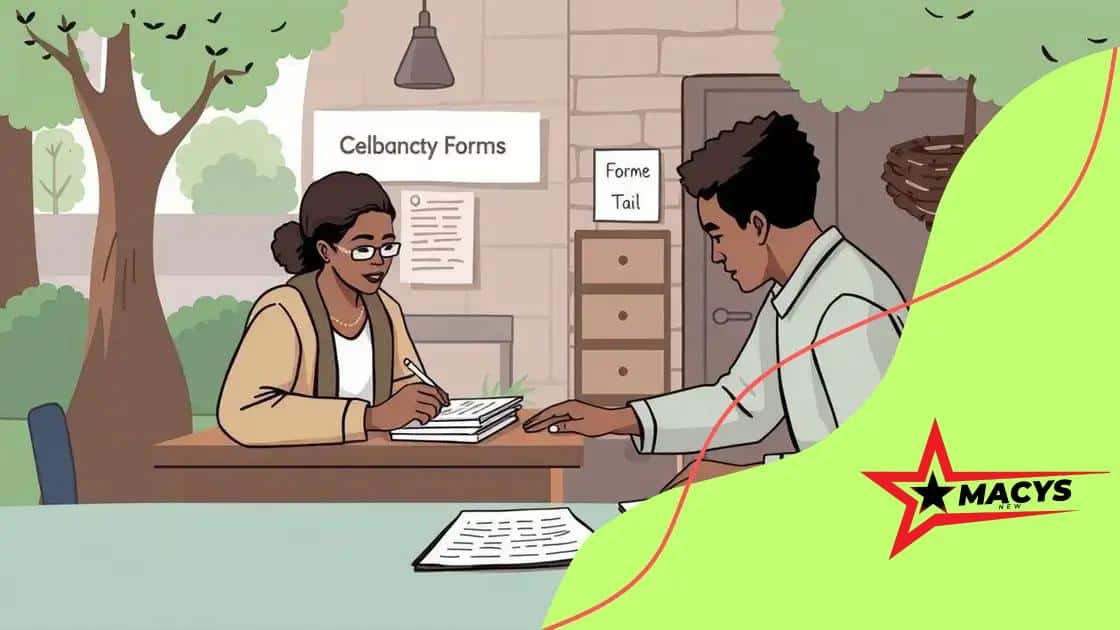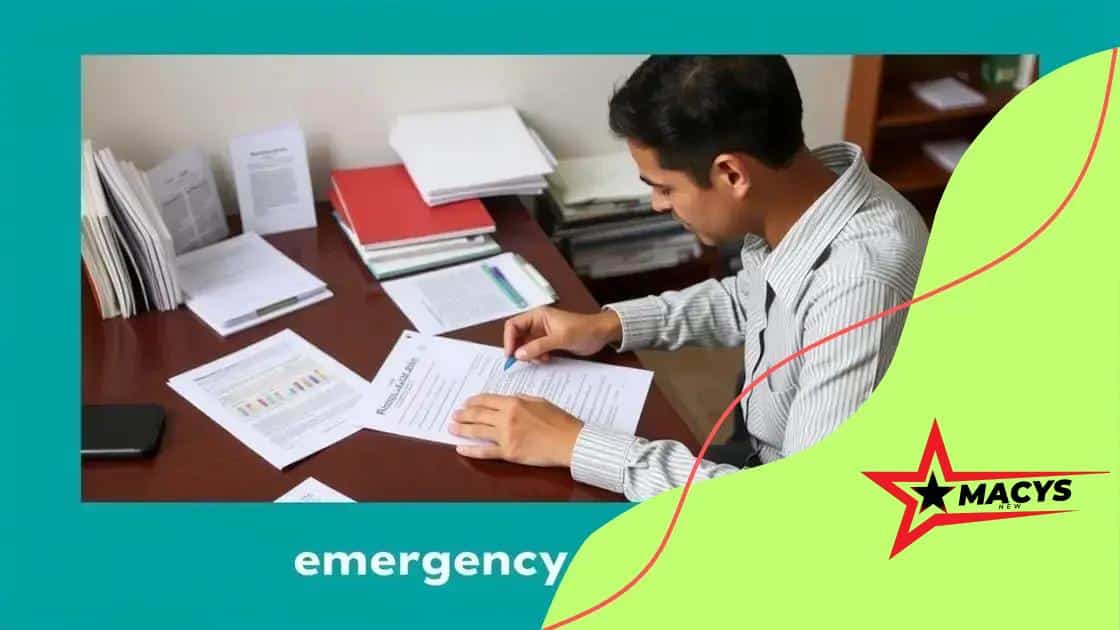Emergency financial relief programs in response to crises

Emergency financial relief programs are designed to provide immediate assistance, including cash grants, food support, and housing aid, to individuals and families facing financial crises.
Emergency financial relief programs in response to crises serve as a lifeline for individuals facing sudden economic hardships. Have you ever wondered how these programs are structured to assist those in need? Let’s dive in and explore.
Understanding emergency financial relief programs
Understanding emergency financial relief programs can help individuals navigate difficult times. These programs are designed to provide quick assistance when unexpected challenges arise, such as natural disasters, economic downturns, or public health crises.
How Do These Programs Work?
Emergency financial relief programs typically function by channeling funds to those in need through various organizations, including government agencies and non-profits. When crises occur, these organizations assess the situation and determine the best way to distribute resources effectively. Often, they ensure that the most vulnerable populations receive help first.
- Quick assessment of needs
- Eligibility criteria for assistance
- Speedy distribution of funds
Individuals looking for support usually need to complete an application process. This process may involve providing proof of income, expenses, and the nature of the crisis. Often, it is designed to be straightforward, ensuring that assistance can be granted swiftly.
Types of Assistance Offered
The types of aid provided can vary significantly based on the triggering event and the program’s focus. Common forms of assistance include cash grants, food assistance, and housing support. Below are some examples:
- Direct cash transfers to individuals
- Food vouchers or free meal programs
- Emergency shelter or temporary housing options
Each program might have different eligibility requirements, so it’s essential to research options available in your community. Understanding these programs allows people to access the help they require when facing challenging circumstances. Furthermore, many organizations promote awareness to ensure those impacted know their rights and the aid available to them.
Types of financial relief available
When it comes to types of financial relief available, various options exist to assist those in need during times of crisis. Understanding these options is crucial for anyone seeking help. These relief programs can be tailored to address different circumstances, providing the necessary support.
Direct Financial Aid
One of the most common forms of assistance is direct financial aid. This can come in the form of grants or cash payments that do not require repayment. Such support is often provided quickly to help individuals cover urgent expenses like:
- Rent or mortgage payments
- Utility bills
- Medical expenses
This type of aid is essential for those struggling to make ends meet after an unexpected event.
Food Assistance Programs
Food assistance programs play a critical role in providing for families in distress. These programs often include food banks, meal delivery services, and vouchers for groceries. They are designed to ensure that everyone has access to essential nutrition during challenging times. Many communities have organizations dedicated to food relief, aiming to alleviate hunger for those impacted by a crisis.
Housing Support Services
Housing support services are also vital for individuals facing eviction or homelessness. These programs can include temporary housing options, rental assistance, and shelter services. They aim to provide a safe environment for those who have lost their homes due to economic instability or disasters.
Overall, there are numerous types of relief available, tailored to fit different needs. Exploring the options in your area can help you identify the best resources to provide necessary support during difficult times.
How to apply for emergency assistance

Applying for emergency assistance can be a straightforward process if you know what to expect. It’s crucial to gather the necessary information and documents before beginning your application. Understanding the steps can help ensure that you receive the support you need promptly.
Gather Required Documents
Before you apply, make sure to collect all necessary documentation. Commonly required documents include:
- Proof of identity (like a driver’s license or ID card)
- Income verification (such as pay stubs or tax returns)
- Details related to your crisis (like eviction notices or medical bills)
These documents will help prove your need for assistance and speed up the application process.
Finding the Right Program
Different programs have specific eligibility requirements and application methods. Research local agencies and non-profits that offer emergency financial relief. Websites, community boards, and social services offices can provide valuable information. It’s essential to find a program that best fits your situation.
Completing the Application
Once you have the required documents, you can start filling out the application. Be sure to read the instructions carefully, as each program may have unique requirements. Most applications can be completed online or on paper. Take your time to provide accurate information to avoid delays.
After submitting your application, keep track of your submission date and any confirmation number provided. This will help you follow up if you do not hear back in a timely manner. Remember, being proactive is key to receiving assistance when you need it most.
Success stories from beneficiaries
Success stories from beneficiaries of emergency financial relief programs showcase the positive impact these initiatives can have on individuals and families facing crises. Hearing about real people who have received help can inspire hope and encourage others to seek assistance when needed.
Case Study: Helping a Family in Need
One notable example involves a family who lost their home due to unexpected job loss. They turned to a local relief program for help. With the assistance they received, they were able to pay their rent and secure a safe living environment. This support not only eased their immediate financial burden but also allowed them to focus on finding new employment.
A Journey to Stability
Another story involves an individual who faced significant medical expenses following an unexpected illness. The financial aid they received covered medical bills and helped them regain their footing. With the burden of debt lifted, they could return to work and support their family.
- Confidence Building: Many beneficiaries express that receiving aid boosts their confidence.
- Community Support: Stories often highlight the importance of community organizations in providing assistance.
- Motivation for Change: Beneficiaries frequently report feeling motivated to help others after recovering from their struggles.
These success stories emphasize the critical role of emergency financial relief in transforming lives. They highlight how targeted help can lead to positive outcomes, fostering resilience and recovery in the face of adversity.
Challenges faced by relief programs
Challenges faced by relief programs can significantly impact their effectiveness in helping those in need. Understanding these obstacles is essential for improving the response to crises. Various factors can complicate the delivery of financial aid and support services to individuals and families.
Limited Funding
One major challenge is the availability of funding for these programs. Many organizations rely on donations and government support, which can fluctuate during times of economic strain. When demand for assistance rises, limited resources can lead to delays and reduced aid for those in need.
Eligibility Criteria
Another issue arises from strict eligibility criteria that some programs enforce. While these criteria help target the assistance to the most needy, they can also inadvertently exclude certain individuals who desperately require help. Many people may not understand the application process or may not meet the requirements, preventing them from receiving needed support.
- Complex application procedures
- Lack of awareness about available programs
- Inaccessible locations for applying
Additionally, outreach and communication can pose challenges. Many potential beneficiaries are unaware of the resources available to them. Programs must work hard to publicize their services effectively and reach those who are often overlooked.
Finally, the administrative burden on organizations can slow down the process. Managing applications, verifying information, and distributing funds require significant staff and resources. This can lead to bottlenecks that ultimately hinder timely assistance.
In summary, emergency financial relief programs play a vital role during times of crisis, providing much-needed assistance to those facing hardship. While these programs have helped many people, they also face challenges that can affect their effectiveness. Understanding the types of assistance available, the application process, and the success stories highlights how important these resources are. By addressing the obstacles faced by these programs, communities can improve their outreach and support, ensuring that assistance reaches those who need it most. Together, we can work towards a more responsive and effective relief system that truly makes a difference.
\n\n
| Topics | Description |
|---|---|
| 💖 Importance | Relief programs provide essential support during crises. |
| 💰 Types of Aid | Includes cash grants, food support, and housing assistance. |
| 📝 Application Steps | Gather documents, find programs, and submit applications. |
| 🎉 Success Cases | Many beneficiaries have shared inspiring recovery stories. |
| ⚠️ Challenges | Programs often face funding limitations and strict eligibility. |
\n
FAQ – Frequently Asked Questions about Emergency Financial Relief Programs
What are emergency financial relief programs?
These programs provide immediate financial assistance to individuals and families facing crises, helping them address urgent needs like housing, food, and medical expenses.
How do I apply for assistance?
To apply, gather required documents such as proof of identity and income, find the right program, and complete the application process, either online or in person.
What types of aid are available?
Available aid includes cash grants, food assistance, and housing support, all aimed at helping alleviate the impact of unexpected financial hardships.
What challenges do these programs face?
Relief programs often struggle with limited funding, strict eligibility criteria, and the need to effectively reach and communicate with those in need of assistance.





